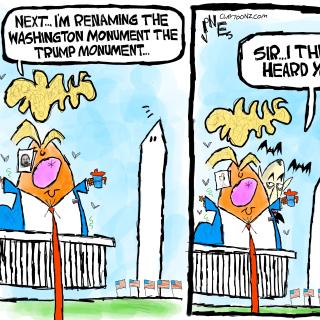Is it an accidental that the stack of tourist literature I found recently at rest stops on the Pennsylvania Turnpike included Youngstown and the Hocking Hills but nothing from Columbus, Ohio? Or should that be expected?
Columbus’ more than two century long crisis of identity and inferiority complex again makes its periodic eruption. Inseparable from its lack of documented history, unrepresentative and undemocratic city government, absence of signature physical or human-made structures, and lack of constructively critical responsible media, these stand out among its claims for uniqueness and exceptionality.
At its core, however, lies the city’s refusal to learn from its own experiences and from any others’. In the 21st century, this is a paralyzing urban condition untreatable in the Les Wexner Medical Center of The Ohio State University. Those two city anchors are known for corporate bankruptcy and close friendship with sexual abuser Jeffrey Epstein, on one hand, and semi-pro football and alienation from its home city, on the other.
The new round of unintelligible, gushing, and self-contradictory confusion launches light in the USA Today/Gannett-owned and directed Columbus Dispatch. On April 20, 2023, its unusually cryptic but always muddled headline (set in Austin, Texas) asks, “Growth, diversity, Silicon Heartland—What is Columbus’ identity and does it need one?” What is it? Does it “need” one? A readers’ response site with a simplistic list of responses accompanies the article by Mark Ferenchik.
No one pauses to reflect on “what is an identity”? Is “identity” singular for all, or plural, divided, and shifting? How does “identity” develop and gain acceptance? What relationship does it bear to the historical and the physical city? What purposes and functions does “identity” serve? No one is aware that there is a large body of writing about this.
As in so much, corporate Columbus—from the official City to the private interests that drive The Columbus Way—desperately desires something they can call an “identity” because other, aspirational cities seem to have one. Something must be marketed for sale. Therefore, Columbus must, too. Regardless of the price in dollars and sense.
In the process, they confuse history, geography, socio-culture, and political economy with marketing and “branding.” With scant linguistic awareness and no comparative knowledge of cities, the Columbus Partnership (whose leaders live outside the city which they seek to own and from which they profiteer), the Columbus Downtown Development Commission (lobbyists and spokespersons for Colemanville), mayor and city council, and The Ohio State University are not aware that they cannot “brand” a city like a calf, sheep, or goat.
Consider this. The Columbus Dispatch, ColumbusUnderground, and what pass for major media lost self-control and literacy when Forbes Magazine included Columbus as a somewhat surprising place in an annual travel list. Reporter Ferenchik read more clearly than city “leaders,” “And again this spring, there was the what now seems to be annual ‘Who knew Columbus had…?’ travel piece… with a line familiar to anyone who has read these stories over the years… ‘I wasn’t expecting….’”
The Dispatch abruptly shifts to “Should it even have [an identity]?” Columbus Metropolitan Club vice-president of programming Doug Buchanan does not know if the city has an identity to “rebrand” but that does not stop him from declaring, “It’s time to rebrand Columbus.” He’s lost in search for the Big C branding iron while others propose changing the city’s name to distance themselves from Christopher Columbus, two of whose City-owned public statutes sit in boxes facing an uncertain future.
The new sources of confusion chase each other in asymmetrical circles. They pivot uncertainly around “growth,” which can mean anything or nothing. Changes in numbers or Ns and percentages, over months, single years, and decades run raggedly into walls. The mayor and his handlers are the worst offenders. Nothing is ever clarified, from population to housing units affordable or not, to violence and murders. Little City data can be accepted at face value.
The Columbus Metropolitan Club, with its history of avoiding expertise for the sake of boosterism in The Columbus Way, wraps itself around “generational change.” But there is never a time in which generational change does not occur. Buchanan stumbles again. In the words of the Columbus Dispatch, “Growth and the city’s changing of the guard are reasons to discuss… the area’s identity.” Typically, he cannot define or specify any such change. There is no “changing of the guard.” That is one real problem for anyone searching for “identity.”
Another dimension is the aspirational economic and population growth of “Central Ohio.” With Gov. DeWine’s purchase of a new Intel micro-chip plant of undefined size for $3 billion as part of his re-election campaign, Ohio and media pundits speak ludicrously of Silicon Valley Heartland, knowing nothing about Silicon Valley or even Phoenix and Tempe, Arizona, among other sites across the US and the midwest.
Ohioans—from the governor to local councils and colleges—ignore at all our peril the limits of Intel’s commitment in number of fabs or factories in Intel-speak, permanent workforce, and degreed engineers. The rush of all Ohio universities and colleges to produce BS engineers will far outnumber available opportunities for employment. Licking County remains unprepared for temporarily housing construction workers. And the massive environmental damage is just beginning.
For Columbus’ mythical and aspirational “identity,” there is no clear direct benefit from Intel or Honda’s plants beyond the airport named for John Glenn who had no direct relationship to the city. City and region are not synonymous, a simple point completely lost on Niel Jurist, president of the Columbus Metropolitan Club Board and senior director of communications for the Mid-Ohio Regional Planning Commission, an apparent conflict of interest in itself.
Jurist recalls Dorothy in Wonderland. “It’s really a great time to redefine the central Ohio region. We don’t need to be compared to other cities. If we want to attract top talent, we’ve got to be known for something.” What? Compared to whom? No city is an island. She apparently “felt apologetic for not leaving” Columbus but, she now avers, “it [sic] can’t be that way any more.”
We scrape the rhetorical bottom with “chief brand officer” of Sky Nile Consulting Jennifer Walton who thinks only in terms of ones: “The struggle has been trying to find that singular identity…. The brand has been Ohio State.”
Unaware that Ohio State is not a “brand” and that no city’s “identity” is “singular,” she is lost between her trees: “What we’re missing is the forest through the trees. We’re truly a melting pot of cultures. The growth is going to be from more diverse groups….”
Ms. Walton, neither forests nor trees melt short of a conflagration. All serious students learn that “cultures” do not “melt.”
Nevertheless, she asserts, “I think you can have a singular identity of a melting pot where differences are celebrated and elevated…[whereas] there can be more people building communities of like-minded values.’ I must admit I am lost in her forest of trees that melt but remain different. This is quite a “brand”—perhaps a “firebrand”--but certainly no identity.
Another predictable trope rolls like saliva from Andy Ginther’s tongue: “Columbus opportunity city.” As timeless, sloganeering, and untrue as “the melting pot,” it is a gross distortion of reality. Columbus, perhaps more than most cities, is a “city of opportunities for the few, not the many.” That is The Columbus Way, private over public, in all dimensions. If the now minority majority city council is a guide, “opportunity city” translates to the assimilation of a few diverse residents into The Columbus Way.
In the Harvard Graduate School of Business extra-curricular script, Kenny McDonald of New Albany, recently installed head of the Columbus Partnership, imagines, no ideologizes “once people arrive here, they can have a real impact. You can contribute, weigh in. That’s not true everywhere. The more diverse we get, the more it becomes true. It’s not a rag line and a brand. It’s really living up to that that and communicating it. We do the hard work of inviting them to the table.”
Of course, McDonald does not, and cannot, say who, when, where, what, why, and especially so what? As usual, there is no there, there. That, too, is The Columbus Way.
The Columbus Dispatch story prompted two immediate published responses. Ohio State University Distinguished University Professor of Geography Emeritus and author of the rare documented book on the city, Boomtown Columbus (2021), wrote an opinion essay, “Columbus isn’t La-La Land, Beantown or the Big D. What it is anguished but why?” (Columbus Dispatch, Apr. 26, 2023).
Quite fairly, Cox intellectually smacks the mad search for identity, mockingly “branding” it “long…a source of anguish.” He argues idealistically and a bit romantically, “The idea of a purposeful search of an identity as suggested here, is a non-starter. It has to be organic, emerging from the bottom up. Was it a committee or notables who came up with La-La Land, Beantown, or Big D?”
As a historian and author of The Dallas Myth (2008), I note that organic is not the same as historical and contextual. “Big D” differs in its origins and promotion from Beantown and others. It is corporate marketing.
Cox is correct, however, in arguing that “Trying to impose something risks absurdity.” While Glenn is not of Columbus, O’Hare and LaGuardia were Chicagoans and New Yorkers. Moreover, Columbus’ lack of identity derives from far more than its population size over the years.
Taylor Dorrell also pushes on the “identity question” in his “Columbus already has an identity and it’s not pretty” in Matter News (April 27, 2023). Without acknowledging others who have made the same point, he observes “the city’s identity lies within its very lack of one” suggesting from not probing the city’s long-standing and continuing historical, geographic, socio-cultural, and political economic contradictions.
Only when Columbus, Ohio, accepts that it is a physical place with a history, and a contradictory path to present and possible futures can it begin to open questions about its “identities,” not “brandings.” I
t must confront its anti-democratic history. It must reject instant identifications with colonizer and enslaver Columbus; grow beyond a large but disorganized public university that will not acknowledge its occupation of Indigenous lands and give at least as much to its surrounding city as it takes.
It must stop proclaiming every newly announced new high rise as the mark of a “new era,” develop its public spheres and limit the power of the private interests that have dominated it from its earliest years. It must reject identification with a hotel mis-named for Ben Franklin’s—and both left-and right-win—Juntos, and a bar named for colonizer and mass murderer Teddy Roosevelt.
It must stop destroying its neighborhoods and its environment. It must rebuild its streets and sidewalks, and clean up its trash.
Perhaps then, others will stop asking: Columbus, where or which one? And stop saying (or singing) “Goodbye Columbus.
Perhaps.
--------------------------------
Harvey J. Graff is Professor Emeritus of English and History at The Ohio State University and inaugural Ohio Eminent Scholar in Literacy Studies. Author of many books, he writes about a variety of contemporary and historical topics for Times Higher Education, Inside Higher Education, Academe Blog, Washington Monthly, Publishers Weekly, Against the Current, Columbus Free Press, and newspapers. Searching for Literacy: The Social and Intellectual Origins of Literacy Studies was published in 2022. My Life with Literacy: The Continuing Education of a Historian. The Intersections of the Personal, the Political, the Academic, and Place is forthcoming. Reconstructing the “uni-versity” from the ashes of the “multi- and mega-versity” is in preparation.



